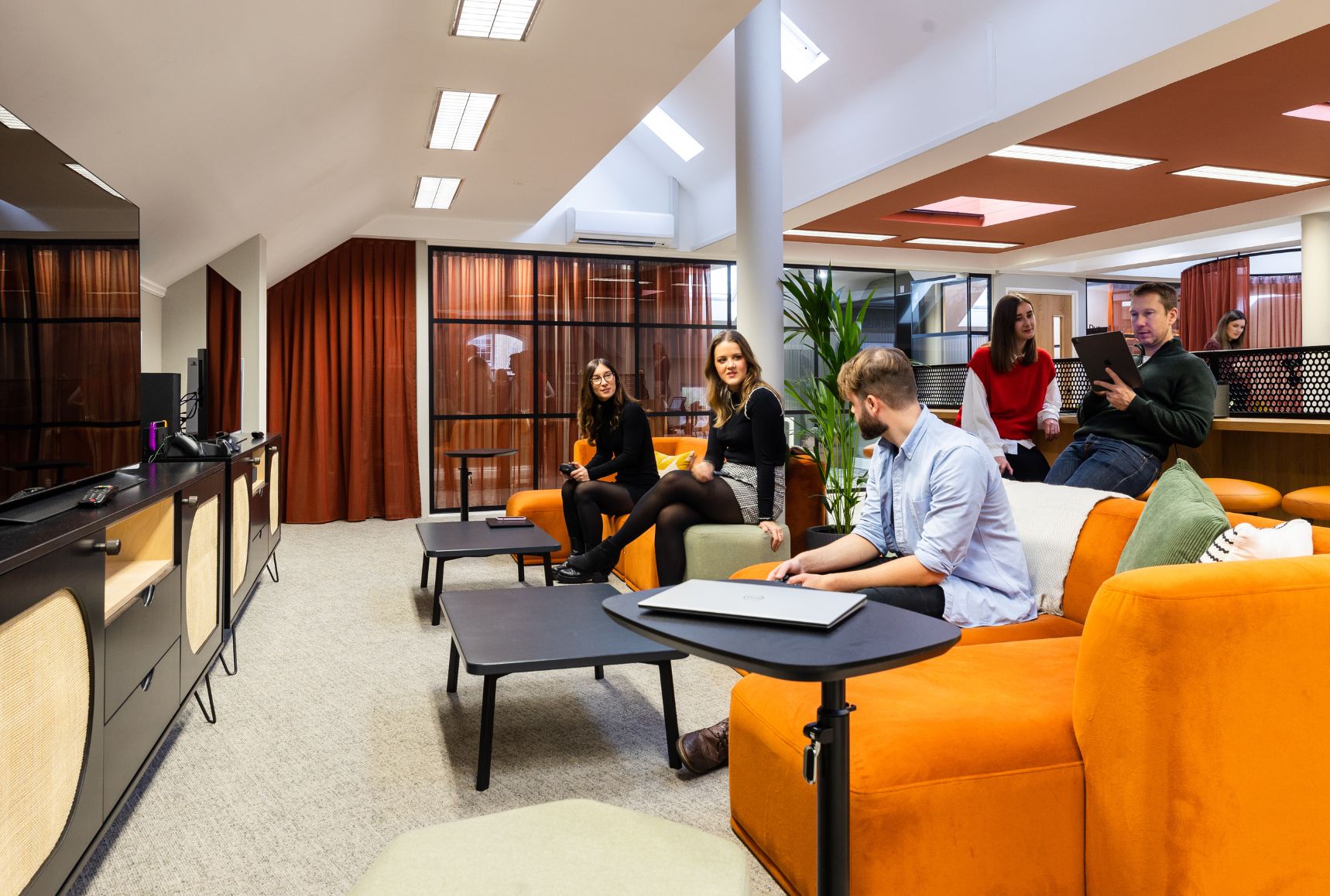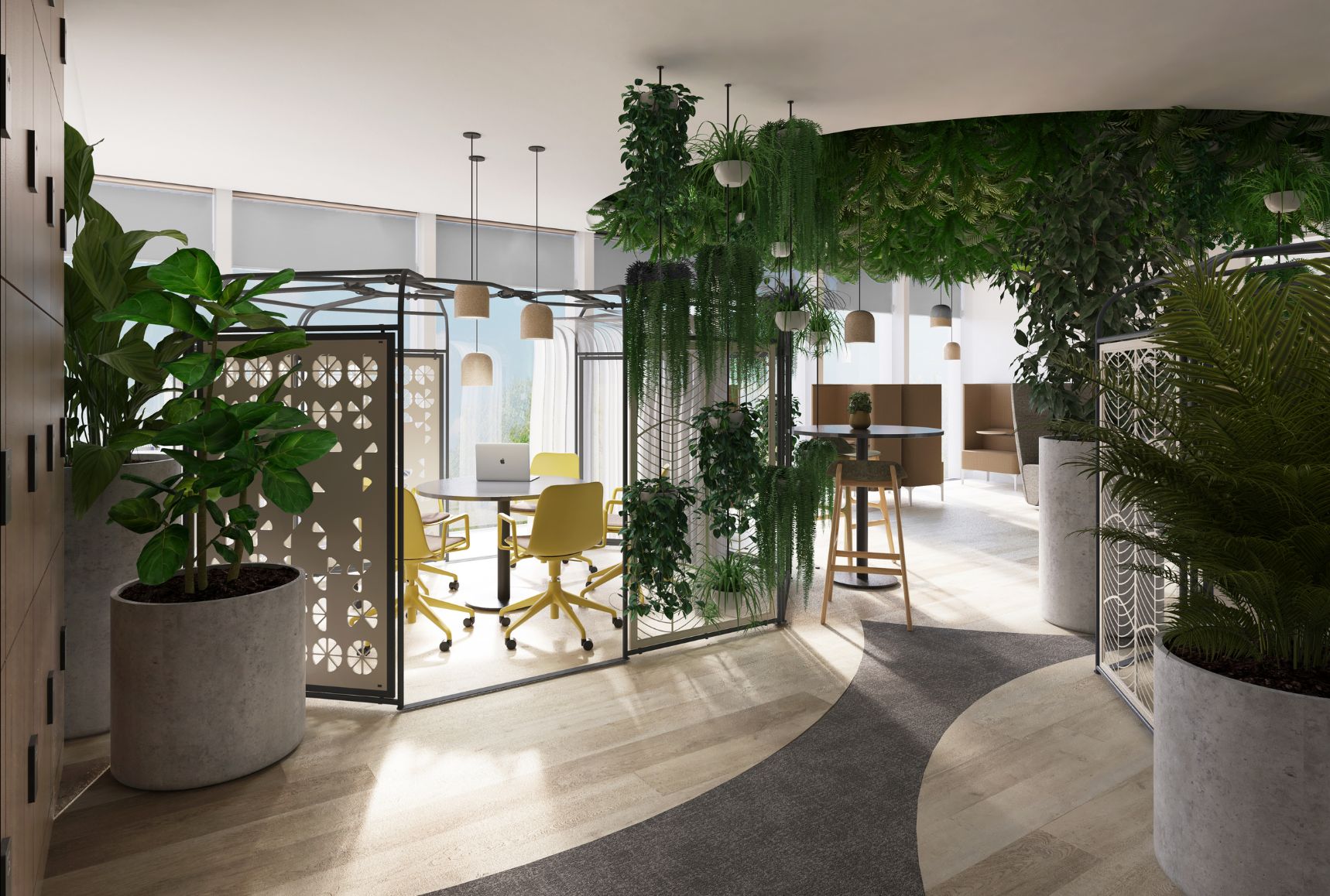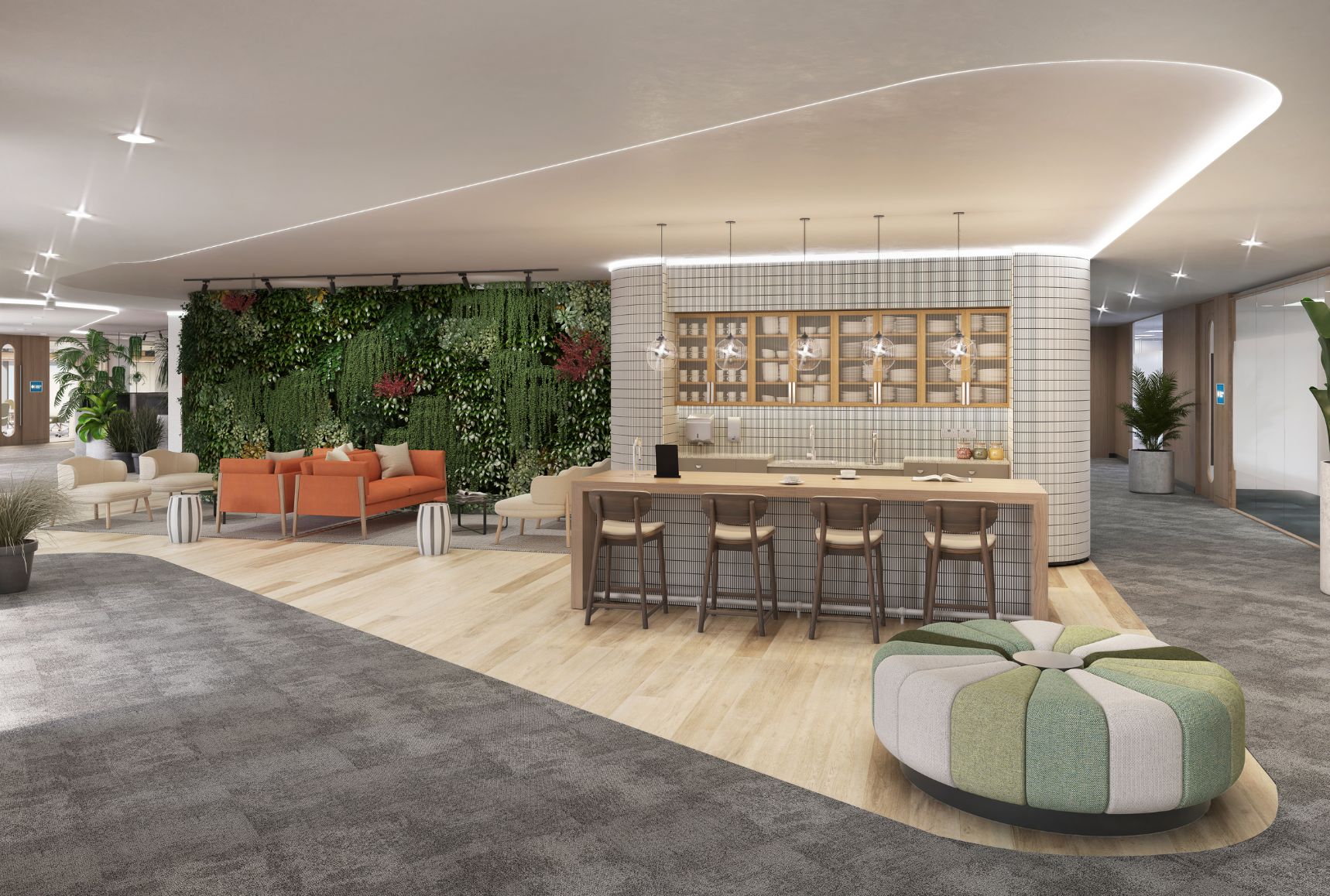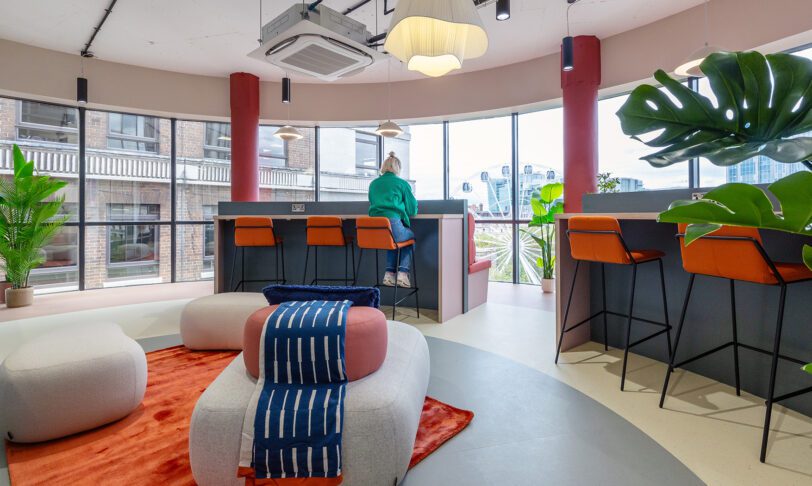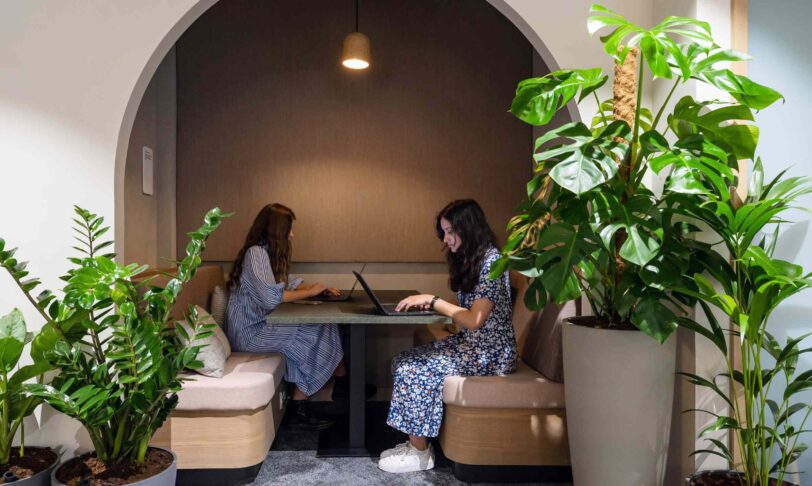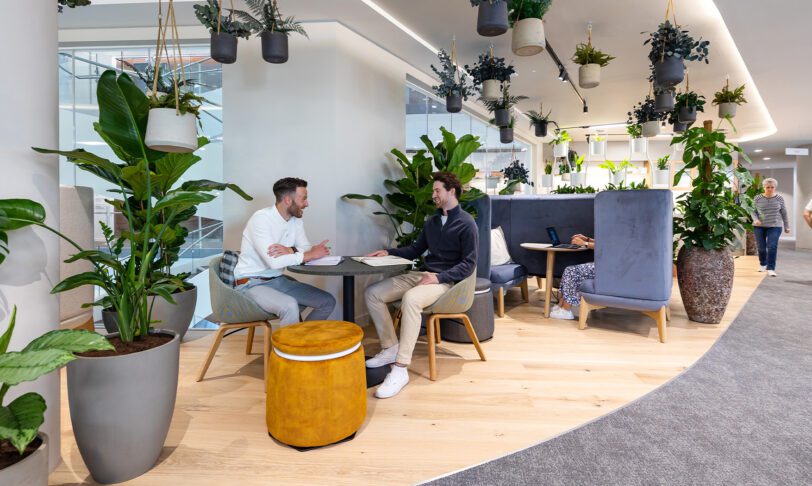Understanding office design and productivity
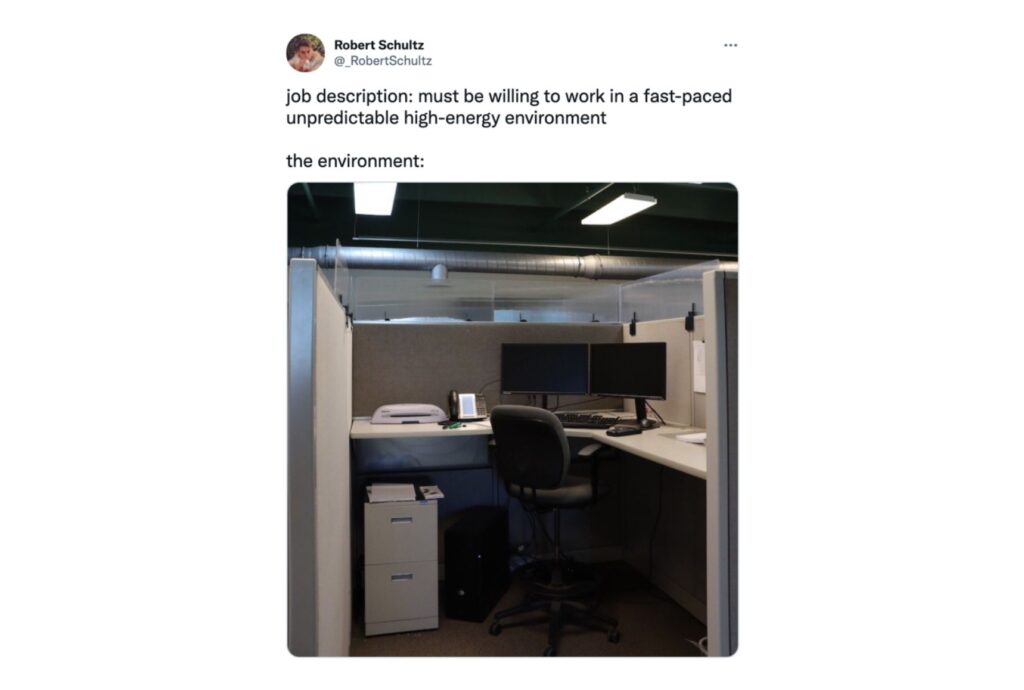
A picture really paints 1,000 words, doesn’t it? It’s a common paradox: expecting people to be as productive as possible in the least inspiring environments you can imagine.
Leaders should constantly envision new ways to help people fulfil their potential. This means creating a space where they feel happy, engaged and able to channel their energy into meaningful work. This article will offer a comprehensive overview of how this can be achieved, with a focus on designing office spaces that boost productivity and creativity.
How important is a workplace environment for productivity?
What exactly is it that makes people productive? As you may expect, it’s not micromanagement or Big Brother-style monitoring. People are productive when they understand the task at hand, but even more so when they’re genuinely motivated to complete it. This means they know what the point is behind their work and they’re in an environment that allows them to think, focus, and flex their creative muscles.
If you’re seeing drops in productivity, you should trust your employees enough to know that they aren’t simply slacking off. After all, that doesn’t make work go away – it simply delays the inevitable and often complicates things even further. Instead, the focus should be on identifying barriers to productivity such as cluttered or uncomfortable workstations or a lack of quiet spaces where employees can get in the zone or mull things over.
You must also ask yourself whether your workplace prioritises style over substance. For example, your desks and chairs may be easy on the eyes but hard on the back or neck. Those glass office doors may scream ‘industrial chic’ but make employees feel exposed when they need a private area to focus. A great office space masters the balance of form and function.
Ultimately, if you invest time and resources in creating the right environment, you’re increasing long-term productivity and growth by setting people up for success.
Is there evidence that office design affects productivity?
Many factors affect office design: not just goals and brand identity but also the actual resources companies have to work with. In an ideal world, every organisation would not only have a cohesive vision but also all the resources they need and a blank canvas to bring their vision to life. But as we all know that is often not the case.
When companies have to make it work with what they’ve got, there’s a chance that productivity as a design factor may get lost in the shuffle. But the impact of office design on productivity can’t be overlooked. Data collected by Savills UK for the 2019 edition of their publication What Workers Want revealed some illuminating statistics about the relationship between office design, productivity, and employee wellbeing:
- 65% of people believed that if the current office design reflected their ideal workplace, this would improve their productivity.
- 37% of people who work in open-plan offices think their office layout decreases productivity.
- Only 34% of people have been asked by their employer what their opinion is on their work environment.
- 21% of people said that the internal design or fit-out is what they would like to change most about their current workplace (compared to 9% saying their colleagues and 12% saying their line manager).
Interaction’s Ultimate Guide to Office Fit-Outs
Business owners, landlords and property developers can find everything they need to know about office fit-outs in our guide, including strategy, budgets and finding the perfect location.
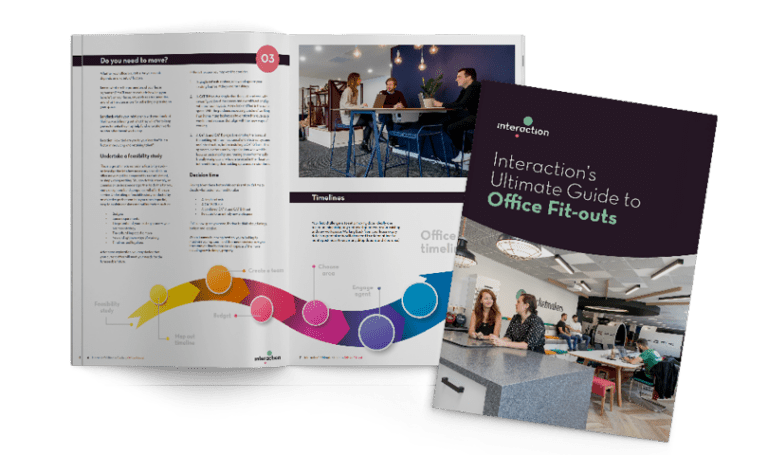
How does office design affect productivity?
We’ve begun examining the potential links between office design and productivity. Now comes the challenge of pinpointing which elements of an office give employees a real kick-start to their day, and which ones tend to drag them down. Think some nice new plants will help people flourish? While the impact of these small touches can’t be underestimated, if there are productivity issues you must find the root cause. These examples should help you dig a little deeper…
Office layout and productivity
Being able to move freely throughout the office is key to productivity. While a bit of alone time can do wonders for concentration, our productivity tends to wane when we feel too confined. Simply moving from one space to another can help us clear our heads and approach tasks with a fresh pair of eyes. However, if research into open-plan offices and productivity is anything to go by, it seems our distaste for cramped cubicles may have gone too far the other way.
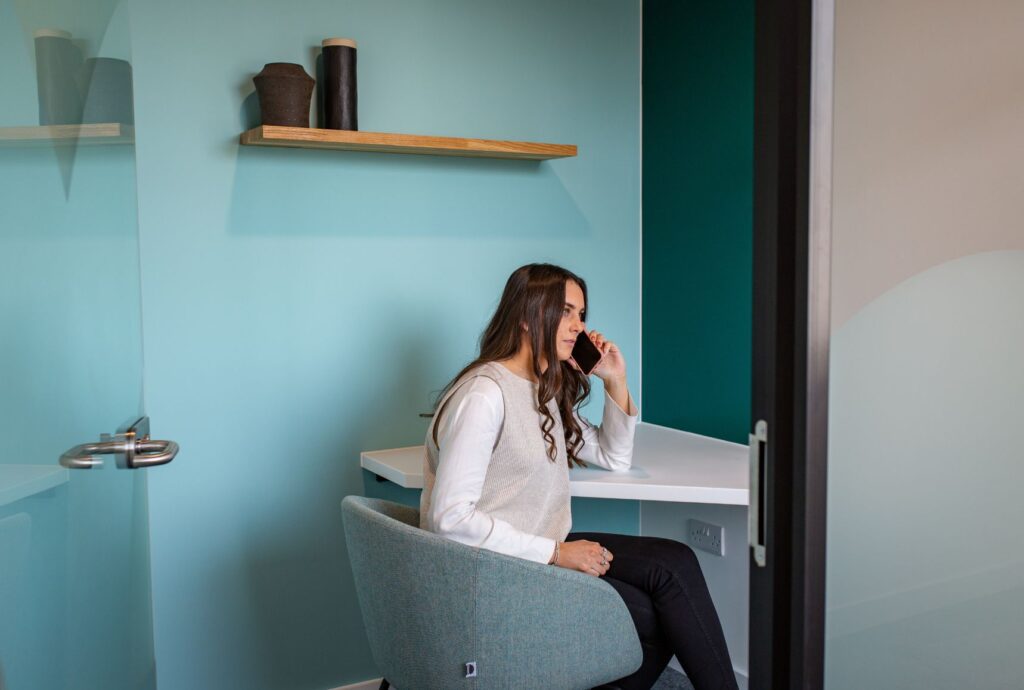
Are open-plan offices actually good for productivity?
Given how important it is for people to have open space and unrestricted movement in the workplace, by all accounts open-plan offices should be fantastic for productivity. So why is it that, to repeat a key statistic, 37% of people believe open-plan layouts are detrimental to productivity? Here are just a few reasons:
- Lack of privacy: A private workspace allows us to have more control over our surroundings – we can set up our desks to match our ideal approach to working. We are less likely to do so when we feel that anyone can strut over and offer their own two cents on what’s best for productivity – which is distracting in itself.
- Increased distractions: While some people may appreciate a little bit of hubbub, others prefer silence when they’re trying to concentrate. In open-plan offices, there’s much more chance of being distracted by workplace chatter, phone calls or a colleague who types so loudly it’s a miracle their keyboard is incapable of feeling pain.
- Too many emails and instant messages: Research has found that open-plan offices reduce face-to-face communication. Instead, you’re much more likely to receive an email or a Slack notification – which can abruptly pull us out of whatever task we’re working on. This is another example of increased distractions in open-plan offices, and apparently it can take up to 30 minutes to fully regain focus after the initial distraction.
If you want to have an open-plan office, you should also have additional facilities for other types of working or socialising. Common examples include private areas or ‘pods’ for solo working and deep concentration, as well as meeting rooms or ‘breakout spaces’ so people can take potentially distracting conversations elsewhere. Need some design inspiration? Take a look at how we created a vibrant, sustainable office for the Institute of Physics Publishing that’s perfect for teamwork and puts employee wellbeing front and centre.
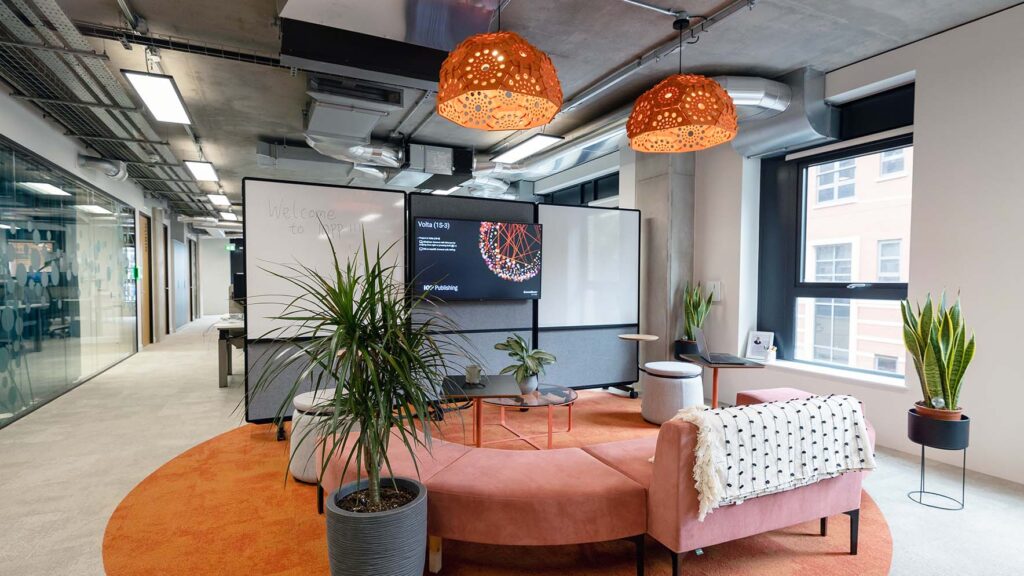
What is the best office layout for productivity?
Your business employs a diverse range of people who perform a variety of tasks. It therefore makes sense to have designated areas to accommodate different types of work. You don’t want one set of workplace needs interfering with another, but at the same time, you don’t want people feeling cooped up and confined.
Open-plan offices were initially thought to promote feelings of freedom and encourage collaboration. But it’s also possible to exceed human scale – creating spaces that are so expansive and busy that the average person could start to feel overwhelmed.
The new trend is towards “broken-plan” offices in which floor space isn’t completely partitioned off while still allocating specific areas to various activities. Instead of building physical walls, spaces are defined in different, more creative ways. The way furniture is placed, and even details like the type of flooring used in each area, help people to identify the right area for different types of activity.
A thoughtful approach to acoustics design also helps to reduce sound travelling between designated ‘zones’, so that teams can easily switch from one mode of working to another (e.g. collaborative, brainstorming or deep focus) without being distracted by what’s going on around them.
Chat with Charlie
Get in touch with Charlie, our Relationships Manager to discuss how we could revolutionise your space.
Email: [email protected]
All general enquiries
Phone: 01225 485 600
Email: [email protected]
Or sign up for our newsletter here

Office interior design and productivity
A strategic approach to office design can give us parameters and guidelines to help get those creative juices flowing. For example, say your brief is to design an office interior to maximise productivity. We can narrow down your options so you aren’t overwhelmed by a seemingly endless range of choices.
Colour
Scores of studies have established connections between office colours and productivity. For example, blue is a colour that most people favour and feel comfortable with while soft greens help to evoke feelings of serenity and calm.
There are, however, a few things to consider when drawing inspiration from colour psychology. For example, there could be some unexpected limitations based on people’s personal tastes and their own associations with specific colours. There’s also the risk of going overboard with certain colours. For instance, while warm colours like yellow are believed to encourage feelings of energy and optimism, overusing them can irritate the eyes and may even cause headaches. Neutral colours are, of course, easy on the eyes, but there’s a risk of your office feeling bland and sedate if a neutral palette isn’t relieved by certain pops of colour. To quote a tried-and-tested piece of meeting filler: It’s just about finding that balance. Find out more in our guide on how office colour impacts productivity.

Lighting
Have you ever worked under fluorescent lights or been stuck in a dark corner of the office? It’s sure to have affected your productivity. And aside from the quantity and quality of light, direction also matters. For example, light from behind can make computer screens difficult to see, whereas lights in front of your workstation create glare. Indirect light is generally thought to be the best compromise, and natural light is preferred by most people. When improving office ergonomics for better productivity, remember to take lighting into account.
Adjustable lights present a possible solution where artificial light is needed, and light fittings that diffuse light can also help to prevent glare, dingy corners, and eye strain. Lighting design is a productivity essential, and it must take people’s individual perspectives into account.
Materials
Texture and fabric are often overlooked when designing offices. Upgrading office chairs with more comfortable or luxuriant fabrics, or using glass tables to reflect natural light, can have a positive impact on productivity.
It’s an under-researched field, but consider your own responses to texture. Warm finishes like wood and soft, upholstered furniture are likely to make you feel comfortable and at ease. And, just as colour contrasts liven up spaces, you can use textural contrasts to make office spaces a bit more dynamic. On the other side of the coin, a fast-paced environment where action takes precedence may benefit from cool, smooth, harder textures with the occasional touch of home-like comfort to keep them friendly and welcoming. Just as we’re able to set the mood for productivity with colour, texture plays into the overall impression spaces create.
Office space and productivity
Just as people need room to move, they also need space to perform at their best. So, how much space should each person have? 2023 British Council for Offices Density Recommendations suggest a research-based allocation of 10 to 12 square metres per worker.
Of course, the type of work being done also affects how much space is needed. Trying to pack too much into too small a space leaves people feeling confined and uncomfortable – especially if they have to spend most of their day at their desks. But great office design allows you to transcend mere square meterage as a basic requirement for productivity and take things to the next level.
Freedom of choice stimulates people, and self-determination contributes to their feelings of workplace engagement. Having the freedom to move between spaces and choose the right environment for their moods and the work they’re doing can give them a productive edge. Craving a little greenery? Hoping to find a quiet and comfortable corner for contemplation? Your offices allow employees to select the spaces they need to produce the best results.
If their work requires collaboration, people need more space than they would if they were working alone. Instead of allocating huge spaces to each individual who must work with others on occasion, you can address this issue by creating spaces for solo work, collaborative work, and creative brainstorming.
As the Harvard Business Review points out, offices that allow individuals to choose their working environment create feelings of empowerment. Whether it’s a need for solitude, stimulus, or rejuvenation and refreshment, good office design can accommodate your employees’ needs and by doing so, reaps the benefits of heightened engagement and productivity.
Are biophilic offices better for productivity?
Biophilic offices bring the outside in, tapping into our affinity for the natural world and creating green spaces where people can work and thrive. For many people, their ideal office is a veritable jungle, and studies have consistently shown how interacting with nature does wonders for our productivity and wellbeing.
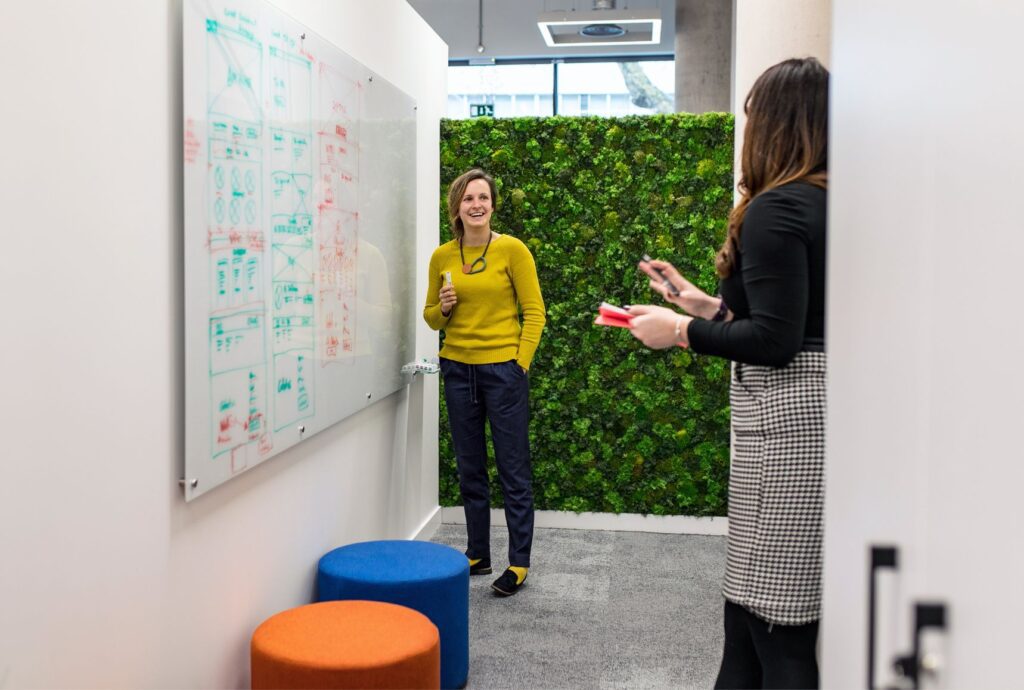
Green Plants for Green Buildings is an organisation that promotes the many benefits of natural elements in built environments. Their research is chock-full of insights, especially as far as productivity is concerned. A 2021 report detailed how having plants in the workplace can lead to:
- 12% increased productivity
- 19% improvements in concentration
- 15% higher levels of creativity and wellbeing
You could simply scatter plants throughout your office or perhaps be more ambitious and include a living wall (also known as a ‘green wall’). Some workplaces also have dedicated relaxation zones that are teeming with plants. For example, Interaction has been contracted to design a new Bristol flagship office for Osborne Clarke, a multi-national law firm. Set to be one of the UK’s greenest office buildings, one design feature we’re particularly excited about is the addition of indoor gardens. These will act as peaceful, uplifting spaces for employees working away from their desks.
No matter how you choose to incorporate biophilic elements in your office, they’re sure to have an uplifting effect on people’s wellbeing (and consequently their productivity).
Office furniture and productivity
According to Savills UK, 92% of survey respondents view the comfort of their work area as highly important. This may seem like common sense, after all, who doesn’t want to be comfortable at work? But sometimes furniture is chosen based on aesthetics rather than functionality.
Your office needs ergonomic furniture that supports a healthy posture and reduces stress in key areas such as the back, neck and hips. Ergonomic furniture is fully adaptable, and including it in offices shows a recognition that people have different requirements and comfort levels. This can be taken one step further with height-adjustable desks, which have proven benefits for wellbeing and productivity. For example, a study of NHS staff in the British Medical Journal found that participants who used a standing desk reported lower levels of anxiety and fatigue and higher quality of life.
Want to know more about how office furniture affects productivity? We’ve created an ultimate guide to ergonomics so you can be fully up to speed on how to help employees perfect their workstations and individual work set-ups.
How do desk layouts affect productivity?
As you’d expect, sitting cheek-by-jowl with other employees will have a negative impact on productivity, but what about the layout of individual desks? The first point to consider is storage space. It’s often overlooked (after all, it’s not the most scintillating aspect of office design). If your workspace is often in disarray, this is obviously bad for productivity – how productive can you be when you’re spending your time trying to find a particular file or piece of equipment? While your office needn’t reach Marie Kondo-levels of tidiness, it should have the type of storage required for an efficient and productive work environment.
To be productive, desk layouts should include all the necessities that help your employees get things done. You’ll also focus on physical comfort. Simple things like considering how the distance of screens from their users helps eye comfort can help to boost workplace wellness and productivity. Adjustable desks and chairs allow employees to personalise their workspaces to match their frames, and easy access to office equipment and storage units limits frustration while helping workers to perform simple tasks more easily.
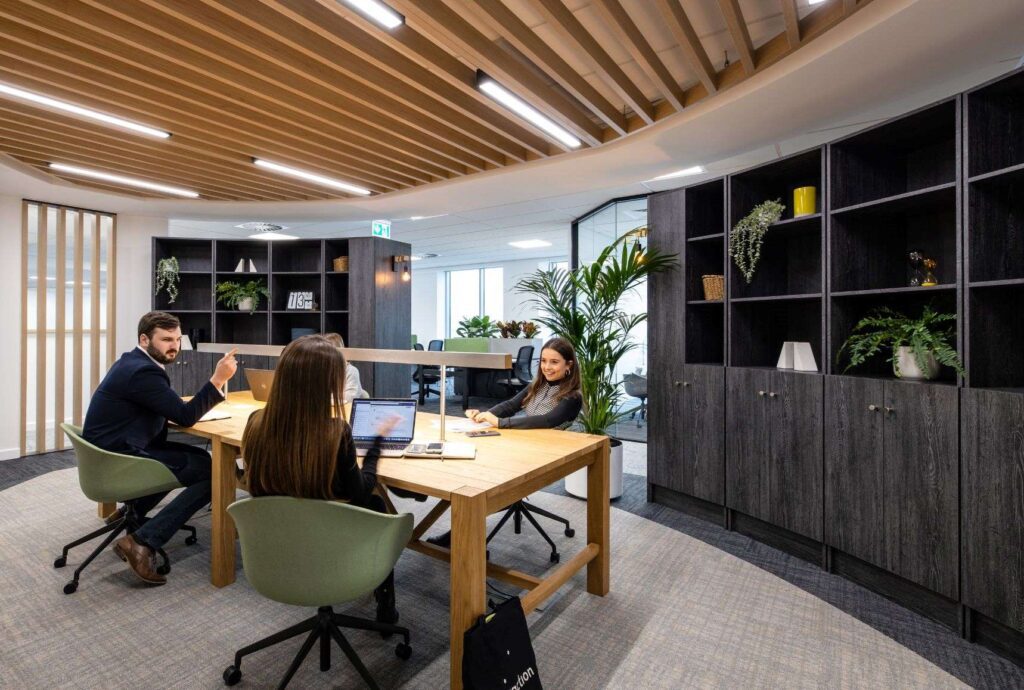
Office acoustics and productivity
Office acoustics present a remarkably detailed field of investigation. It’s not just the way sound travels across office floorspace, but also how it’s transferred through ductwork or other service openings.
Are your employees constantly distracted by discussions they won’t benefit from? Are they overhearing confidential meetings? Do they struggle to hear things they’re really meant to hear? Office acoustics are worth considering when planning your new office layout. Unnecessary noise can be cancelled out and voices that should be heard can carry. Design intent ensures a workable solution.
Hybrid office design and productivity
These days, many businesses are working with hybrid employment models. It’s a way of working that allows employees to work remotely while having in-office days to connect with their employers and colleagues. Needless to say, those in-office days are vitally important to employee engagement and, if your office design matches their need for connection, they’ll find that their “office days” are something to actually look forward to.
In most instances, hybrid workers go to the office to collaborate with their team. Therefore, productive office days require spaces that are designed with interaction in mind. They should stimulate creativity and allow for collaboration and socialising, reinforcing a sense of cohesion and belonging.
Flexible office design and productivity
Flexibility in office design means spaces are adaptable to an array of changing needs. By tailoring office space to people’s specific requirements, a focus on flexibility can do wonders for productivity.
Flexible offices and broken-plan designs work well together. The lack of physical barriers allows spaces to be repurposed as needed. Planning a meeting that everyone should attend? You don’t need a huge meeting room that’s barely ever at full occupancy. If your office allows for flexible space utilisation, you can create your meeting space in minutes and then quickly restore it to its original purpose.
Adding extra employees during busy times or growing your business and workforce? A flexible office design and build helps you to fit new people into your space without making them feel like an afterthought or spare part.
Flexibility in design also gives employees options. They can decide where they want to work based on how they feel and what they are doing. If they want a quiet space, it’s there for them. If they prefer a space where they can chat and collaborate, that’s also an option. Just having these choices can help employees experience a sense of self-determination that boosts engagement.
Inclusive office design and productivity
Inclusive office spaces offer a multitude of benefits, including a wider variety of perspectives and access to a broader range of talent. At the same time, your employees will feel valued for who they are and what they bring to the table.
Many people see inclusivity as a simple matter of accessibility for people living with disabilities. But while an inclusive office allows people facing mobility or sensory challenges (such as sight or hearing impairment) to feel comfortable, it also recognises intangible aspects of inclusion. These might include the spiritual needs of people from various cultural backgrounds or the provision of calm spaces for those prone to sensory overload.
The equation is straightforward. People who feel happy, included, and comfortable in the workplace are enabled to deliver their ultimate best. And since you want nothing less, providing facilities like prayer rooms or chill-out spaces is an investment in their (and your) success.
Interaction is a specialist office design and fit-out company. We love creating spaces where people can reach their full potential and enjoy what they do on a daily basis.
Want to design an office where everyone can do their best? We can implement a thoughtful workplace strategy for your organisation. Start with a chat with Charlie or call us on 01225 485 600 to speak to a member of our team.
Join the Interaction community
Sign up for our newsletter to stay up-to-date with the latest insights
on the modern workplace and commercial property trends.
